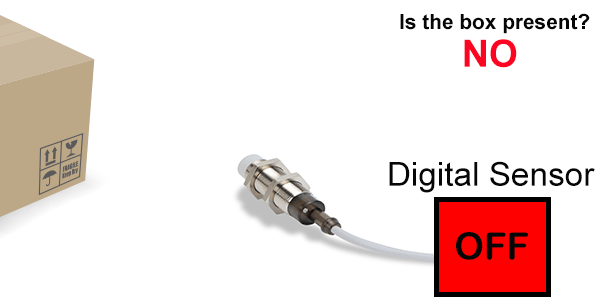Sensors
Table of Contents
| Various Sensors |
|---|
What are Sensors?
Sensors are devices that respond to physical stimulus (such as sound, pressure, heat, particular motion etc. )and output a resulting impulse[1].
The output is generally a signal that is converted to human-readable display at the sensor location or transmitted electronically over a network for reading or further processing [2].
Sensor Detecting an Object |
|---|
Characteristics of Sensors
Digital or Analog Sensors
Digital
The sensors sense external parameters such as wind and it outputs discrete values (0 and 1’s), commonly known as binary signals
Analog
The sensor also sense external parameters and it outputs an analog voltage that might be between 0v and 5v. The signal is also continuous and proportional to the measurand
Range
The maximum and minimum values that the sensor can measure (e.x -40 oC to 500 oC)
Accuracy
It is the ability of the sensor to measure a value that is close to the true value of the measured quantity
It is measured by its absolute or relative error
Absolute error = Result -true value
Relative error = Absolute value/true value
Linearity
This relates to the closeness of the calibration curve to the specified straight line.
For example, the theoretical behaviour, least-squares fit
Sensitivity
It is the slope of a calibration curve. An ideal sensor would have a large and constant sensitivity
A non-linear function exhibits different sensitivity at different points. The first derivative is taken to give us the slope of the sensor whose function is non-linear.
Sensors Use Cases
References
[1] "Definition of SENSOR", Merriam-webster.com, 2020. [Online]. Available: https://www.merriam-webster.com/dictionary/sensor. [Accessed: 03- Nov- 2020].
[2] K. Al-Aubidy, "Sensor Characteristics", Philadelphia.edu.jo, 2020. [Online]. Available: https://www.philadelphia.edu.jo/academics/kaubaidy/uploads/Sensor-Lect2.pdf. [Accessed: 03- Nov- 2020].
[3] How to Electronics, "Top 15 Latest Sensor Projects for Arduino Begineers", Youtube.com, 2020. [Online]. Available: https://www.youtube.com/watch?v=NePXqRwvmbs&app=desktop&ab_channel=HowToElectronics. [Accessed: 03- Nov- 2020].
[4] Illinois Tech, "Sensors: Types and Characteristics", Web.iit.edu, 2020. [Online]. Available: https://web.iit.edu/sites/web/files/departments/academic-affairs/academic-resource-center/pdfs/SENSORS.pdf. [Accessed: 03- Nov- 2020].
[5] RealPars, "What is a Pressure Sensor? | Types of Pressure Sensors | RealPars", PLC Programming Courses for Beginners | RealPars, 2020. [Online]. Available: https://realpars.com/pressure-sensor/. [Accessed: 03- Nov- 2020].
[6] "What is sensor? - Definition from WhatIs.com", WhatIs.com, 2020. [Online]. Available: https://whatis.techtarget.com/definition/sensor. [Accessed: 03- Nov- 2020].
Contributors:
| User | Last Update |
|---|---|
| Mayurakhi Khan | 1254 days ago |








.png?version=1&modificationDate=1632939241270&cacheVersion=1&api=v2&width=267&height=150)
.png?version=1&modificationDate=1632939241480&cacheVersion=1&api=v2&width=154&height=150)